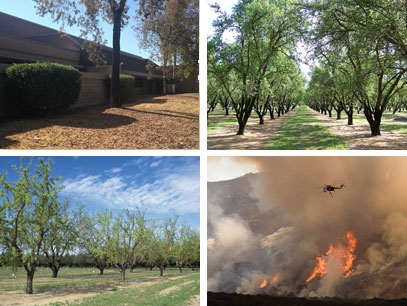
Agricultural cropland
NPR's Valley Public Radio ran a story about salt buildup in almond orchards. Without rainfall to move salts below almond trees' rootzone, harmful levels of salinity are building up in the soil. “We've been seeing this increasing problem over the past couple years, due to the lack of winter rain, of sodium burn or salt burn on leaves," said UC ANR Cooperative Extension farm advisor David Doll. “Rain will do it (leach salts) naturally for us, but if we don't get rain we've been encouraging farmers to actually fill the profile with irrigation water, whatever they can by December. And then hopefully whatever rain we do get will help aid with the flushing of the root system of the tree.”
KCOY,KEYT andKKFX TV in Santa Maria ran a story on new technologies being used by a local strawberry farmer to irrigate efficiently. The farmer installed microsprinklers and moisture sensors on his strawberry field to monitor water and fertilizer inputs. Mark Gaskell, UC ANR Cooperative Extension farm advisor, developed the technology. "By identifying and carefully documenting how much water or nutrients are lost or how much variation there is, a grower can modify their management so that they can be more efficient when applying water," Gaskell said.
Urban landscapes
KQED Science posted an eight-minute interview with UCANR Cooperative Extension urban forestry advisor Igor Lacan. He explained how to irrigate young and mature trees so they won't die during the drought. Why protect trees, even as lawns are turning brown? Lacan says they boost property values, provide shade, filter the air and makes cities more “livable.”
Fire-prone wildland
Scientific American ran a story about the wildfire that swept across I-15 in Southern California last week, setting dozens of vehicles on fire. Firefighters were puzzled by the rapid spread of the fire. “There are two factors that help fires spread - winds and topography,” explained Scott L. Stephens, a professor of fire science in the Department of Environmental Science, Policy and Management at UC Berkeley. “The thing about wind is, it can change so quickly and the fire will change with it — it can happen in 15 seconds,” Stephens said. A fire can also race up a slope very rapidly, he added.